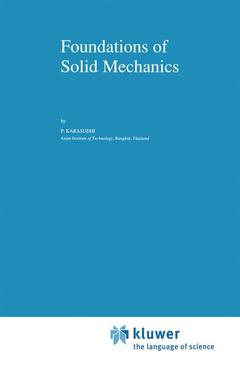Description
Foundations of Solid Mechanics, 1991
Solid Mechanics and Its Applications Series, Vol. 3
Author: Karasudhi P.
Language: English
Subject for Foundations of Solid Mechanics:
Keywords
finite element method; materials; mechanics; plasticity; stress; vibration
Publication date: 09-2012
446 p. · 15.5x23.5 cm · Paperback
446 p. · 15.5x23.5 cm · Paperback
Description
/li>Contents
/li>
This book has been written with two purposes, as a textbook for engineering courses and as a reference book for engineers and scientists. The book is an outcome of several lecture courses. These include lectures given to graduate students at the Asian Institute of Technology for several years, a course on elasticity for University of Tokyo graduate students in the spring of 1979, and courses on elasticity, viscoelasticity and ftnite deformation at the National University of Singapore from May to November 1985. In preparing this book, I kept three objectives in mind: ftrst, to provide sound fundamental knowledge of solid mechanics in the simplest language possible; second, to introduce effective analytical and numerical solution methods; and third, to impress on readers that the subject is beautiful, and is accessible to those with only a standard mathematical background. In order to meet those objectives, the ftrst chapter of the book is a review of mathematical foundations intended for anyone whose background is an elementary knowledge of differential calculus, scalars and vectors, and Newton's laws of motion. Cartesian tensors are introduced carefully. From then on, only Cartesian tensors in the indicial notation, with subscript as indices, are used to derive and represent all theories.
I Mathematical Foundations.- 1.1 Tensors and continuum mechanics.- 1.2 Scalars and vectors.- 1.3 Indicial notation.- 1.4 Algebra of Cartesian tensors.- 1.5 Matrices and determinants.- 1.6 Linear equations and Eigenvalue problem.- 1.7 Theorems on tensor fields.- 1.8 Differential geometry.- 1.9 Dirac-delta and Heaviside step functions.- 1.10 Bessel functions.- 1.11 Laplace transforms.- 1.12 Inverse Laplace transforms.- 1.13 One-to-one mappings.- 1.14 Curvilinear coordinates.- 1.15 Derivatives with respect to curvilinear coordinates.- 1.16 Exercise problems.- II Stress and Strain Tensors.- 2.1 Introduction.- 2.2 Force distribution and stresses.- 2.3 Stress vector and equations of mation.- 2.4 Euler’s laws of motion.- 2.5 Stress tensor.- 2.6 Stationary shear stresses.- 2.7 Octahedral shear stress and stress deviator.- 2.8 Strain tensor.- 2.9 Compatibility conditions.- 2.10 Cylindrical and spherical coordinates.- 2.11 Problems.- 2.12 Exercise problems.- III Linear Elasticity.- 3.1 Strain energy function.- 3.2 Orthotopic and isotropic elastic solids.- 3.3 Young's moduli and Poisson's ratios for orthotropic elastic solids.- 3.4 Solution schemes.- 3.5 Field equations in tenns of displacements.- 3.6 Problems.- IV Elastostatic Plane Problems.- 4.1 Plane problems of orthotropic elastic materials.- 4.2 Airy function for isotropic plane problems.- 4.3 Isotropic elastic plane problems in cylindrical coordinates.- 4.4 Displacement for a given biharmonic function.- 4.5 Examples of infinite plane problems.- 4.6 Particular solutions for concentrated forces.- 4.7 Exercise problems.- Table 4.1 Complementary and particular solutions for elastostatics of isotropic planes.- V Bending of Elastic Thin Plates.- 5.1 Basic assumptions.- 5.2 Equilibrium, boundary conditions and stressresultants.- 5.3 Physical meaning of stress resultants.- 5.4 Governing conditions for isotropic plates.- 5.5 Solutions for rectangular plates.- 5.6 Closed form solutions for circular plates.- 5.7 Series solutions for circular plates.- 5.8 Polygonal plates supported at corners.- 5.9 Plates on elastic foundation.- 5.10 Exercise problems.- Table 5.1 Complementary and particular solutions for elastostatic bending of thin isotropic plates.- VI Elastostatics with Displacements as Unknowns.- 6.1 Field equations for plane problems.- 6.2 Solution scheme for large planes.- 6.3 Solution scheme for large spaces.- 6.4 Homogeneous half planes and half spaces.- 6.5 Concentrated force inside a half space.- 6.6 Load transfer problems.- 6.7 Infinite elements for multilayered half spaces.- 6.8 Saturated large spaces.- 6.9 Exercise problems.- VII Linear Viscoelasticity.- 7.1 Linear elasticity and Newtonian viscosity.- 7.2 Creep and relaxation.- 7.3 Compliance and modulus of mechanical models.- 7.4 Differential equations for stress-strain relationship.- 7.5 Steady state harmonic oscillation.- 7.6 Thermorheologically simple solids.- 7.7 Three-dimensional theory.- 7.8 Quasi-static solution by separation of variables.- 7.9 Steady state harmonic solution scheme.- 7.10 Integral transform methods and their limitations.- 7.11 Three-dimensional thermoviscoelasticity.- 7.12 Problems.- VIII Wave Propagation.- 8.1 Terminology in wave propagation.- 8.2 Wavefront and jumps.- 8.3 Velocity jumps in isotropic elastic domains.- 8.4 Reflection and tansmission at interfaces and boundaries.- 8.5 Waves in isotropic viscoelastic media.- 8.6 In-plane harmonic surface waves.- 8.7 Antiplane harmonic surface waves.- 8.8 Vibration of multilayered elastic half spaces.- 8.9 Asymmetric vibration of a homogeneous half space.- 8.10 Axisymmetric torsion of a layered half space.- 8.11 Total solution to vibration of half planes.- 8.12 Vibration of viscoelastic half spaces.- 8.13 Infinite elements for a homogeneous half space.- 8.14 Exercise problems.- IX Plasticity.- 9.1 Facts from simple tests.- 9.2 Basic assumptions and common characteristics of various theories.- 9.3 Various yield functions.- 9.4 Hardening and flow rules.- 9.5 Incremental formulation for isotropic hardening.- 9.6 Viscoplasticity.- X Finite Deformation.- 10.1 Different descriptions of changing configuration.- 10.2 Material derivative and conservation of mass.- 10.3 Stress tensors in different descriptions.- 10.4 Equations of motion in different descriptions.- 10.5 Finite strain tensors.- 10.6 Reformed Lagrangian description.- 10.7 Strain tensors in curvilinear coordinates.- 10.8 Equilibrium equations and stress tensors in curvilinear coordinates.- 10.9 Physical components of vectors and tensors.- 10.10 Boundary conditions and constitutive relationship in curvilinear coordinates.- 10.11 Compatibility conditions.- 10.12 Problems.- References.- Author Index.
© 2024 LAVOISIER S.A.S.
These books may interest you

Physical Components of Tensors 180.67 €



